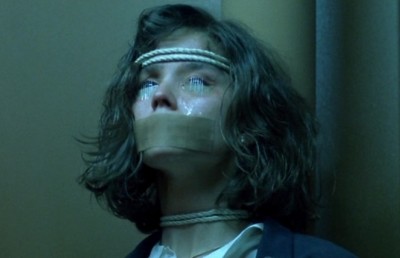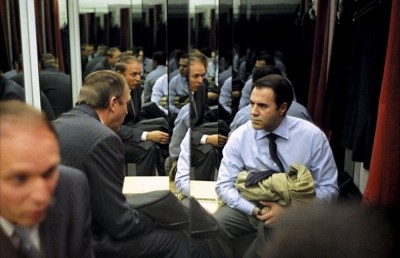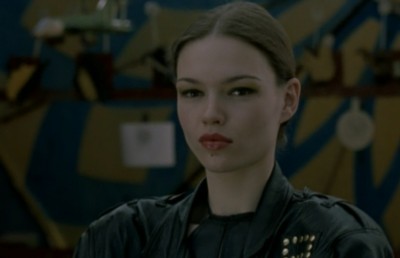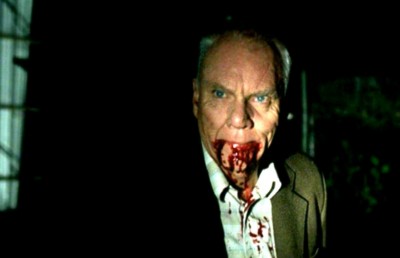Sex and Violence as Phantasm: Eros and Thanatos in Campion’s In the Cut
Serial Killer Meets Art Film
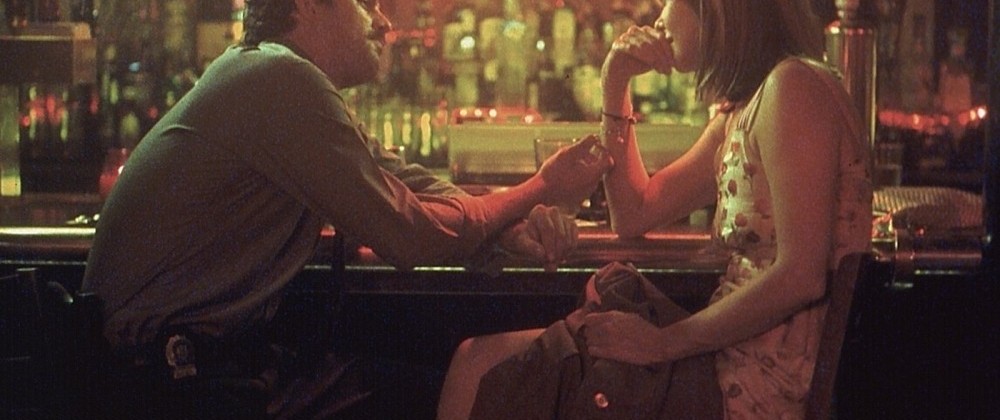
“Midway along the journey of our life I woke to find myself in the middle of a dark wood for I had wandered off from the straight path.”
Dante’s The Inferno
In the Cut might represent a turning point in Jane Campion’s career, or it might only be a wandering off from the path she had previously taken with her first five features. With In the Cut, she plunges deep into the noir world of the serial killer/slasher genre, all the while continuing her exploration of the female psyche, this time through eroticism and sexual desire. Adapted from Susanna Moore’s novel of the same name, In the Cut reveals more than we would expect from the above genre, and dares to underline the drama of female eroticism/masochism, a subject dear to Campion that reaches here its paroxysm.
Frannie (Meg Ryan) is an English teacher who lives in New York City, who collects words and expressions for the slang dictionary she is writing. She meets Detective Malloy (Mark Ruffalo) while he is investigating a murder that occurred in her neighborhood. Her half-sister Pauline (Jennifer Jason Leigh) encourages her to further their relationship, so they begin having an affair; meanwhile the murders continue to mount around Frannie’s entourage. She grows increasingly suspicious that Malloy might be the actual serial killer, but she remains drawn to him and her rising passion, risking herself with him, exposing herself to the latent danger.
Just as Frannie tells her half-sister Pauline that slang is always about sex and violence, Campion’s In the Cut revolves around the constant schematic confrontation between what is male and what is female, that is, how female sexuality is almost continually threatened by male violence. Indeed, if we look closely at the film’s structure we can detect a pattern which aligns with this duality:
| Male | Female |
| Violence | Sex |
| Thanatos | Eros |
| Sadism | Masochism |
| Cold | Warm |
| In | Cut |
The clever tale written by Moore centers around the powerful contrast between what is violent and what is sexual, and the thin line that separates these elements is constantly blurred by Campion, who uses both aesthetic tricks as well as recurrent thematics to highlight the parallel between the masculine entity and the feminine entity. Throughout the film sex and violence entwine in such a way that we are uncertain which one of the two predominates in certain scenes. All of which brings us to the following question: is sexuality inevitably linked to violence in the movie? And when violence occurs, is there necessarily a sexual element bound to it? This question will lead us to analyze the concept of sexualized violence and violent sexuality.
This analysis will be divided into two categories, the first dealing with the themes of the film, notably the relation between sex and violence, expressed as Eros and Thanatos, the use of slang as a way to draw (or drive) sexual tension and violent energy, and finally the exploration of the female psyche. The second category will be devoted to the aesthetics of the film, especially the omnipresence of the color red as signifier for passion, or as a “blood” motif; the “sharp” versus “soft” aesthetics as a way to translate Frannie’s emotions, and finally the dream-like (reverie) feel of the film, which may be Campion’s way of suggesting the phantasmic nature of the film.
The exploration of Eros and Thanatos forms one of the thematic keys to the film. In Freudian psychology, Eros is the libido, the libidinal (instinctual) energy, but also the life instinct innate in all of us. It constantly battles against Thanatos which is the death instinct or death wish, that refers to one’s own need or envy to die. With In the Cut questions arise that have resonance to the Eros and Thanatos concept: Does violence cause sexual arousal? Does sex lead to violent behavior? Are we witnessing sexualized violence or violent sexuality?
The World of Endlessly Possible Male Violence
As my preamble has suggested, In the Cut contains several key scenes where violent and sexual elements are linked. This is borne out by a breakdown of scenes where some sexual or violent content appears, several of which will be discussed below. This device helps to create the love/hate paradox, with sex being the culminating point of love and violence being the strongest manifestation of hate. Having them both closely linked together in the narrative, in proximity one to the other, increases our uncertainty as to what is exactly going on in some scenes (sex or violence) and what the characters’ intentions are, all of which may create a sense of unease and insecurity in an audience.
The first demonstration of sexual activity in the film appears during the scene where Frannie and her student Cornelius are having a drink in a bar, to discuss his paper on serial killer John Wayne Gacy. At a certain point she goes to the toilet, which is situated in the basement. While searching for the bathroom, she witnesses a man receiving fellatio from a woman, whose identities remain unknown because the lighting is too dark for either participant to be clearly identified by us or Frannie. The scene, which is very explicit in the uncut version of the film, abruptly gains a new meaning when the man sees Frannie watching him, and starts to pull the woman’s hair, as if trying to direct Frannie’s gaze, or facilitate it. Clearing Frannie’s field of vision to his penis, his gesture becomes a way of underscoring the importance of the gaze, female desire, and the link between sex and danger. The sudden demonstration of aggressive behavior, as he pulls the woman’s hair, makes the atmosphere change, signifying the proximity of violence to sex. Adding to this sense of danger is also the fact that the scene is lit in stark red lighting, and alludes to films in which “peephole” voyeurism is a signifier for latent danger and murder. [1] Another key clue revealed in this scene is a shot from Frannie’s point of view which establishes a three of spades tattoo on the wrist of the man, an image that will later gain all its significance.

From calm and quiet to edgy, the mood of the film also changes with the introduction of the Giovanni Malloy character, who brings with him words like ‘disarticulated’. The sordid serial killing business he is investigating seems to interest Frannie, even more so when she sees the same tattoo on his wrist as she saw on the man’s wrist in the bar’s toilet. Later, as she masturbates on her bed, she imagines flashes of Malloy in the same position as that of the man receiving fellatio, but this time there are no dark shadows encircling his face: the image is sharp, and it is clearly Malloy that she is thinking of. This train of thought, translated by these fantasy flashes, leads us to suspect that Frannie might be associating Malloy with the possible killer. This scene marks the beginning of the blurring of the line between violence and sexuality, the moment when Thanatos, the drive toward danger and death, begins to take hold of her mind, Frannie having seen the man pull the woman’s hair, and including it in her phantasm.
Later, at a bar, Malloy tells Frannie “I can be whatever you want me to be,” after which she changes the subject and asks, “Why does your partner carry a water pistol?” Following Malloy’s explanation of why Rodriguez lost his right to carry a gun, his partner joins them, at which point Malloy shuns Frannie and the two men begin a lurid conversation filled with remarks linking sex and violence, the ones of Rodriguez clearly being misogynist.
An example of this schematic confrontation between sex and violence occurs in the scene where Frannie leaves the bar in the above described sequence and gets attacked in the street by an unknown man. This demonstration of random, urban violence is followed by an important step in the Malloy/Frannie relationship, as well as in the erotic ethics of the film. In his re-enactment of the attack on Frannie, Malloy assumes the role of the attacker. In his mise en scène he brushes slightly against Frannie’s breast, which triggers in her the will to go further with him sexually, even though at that point she is clearly à fleur de peau, sensing danger but being unable to turn her back to it. This odd mise en scène, so intricately linked to a violent act in the film, leads them to have sex for the first time.
Another scene, perhaps less important, which manifests this constant confrontation occurs in Pauline’s apartment which is situated above a strip club named the Baby Doll Lounge. The action of Frannie reading from Cornelius’ explicit paper on serial killer John Wayne Gacy is intercut with images of the strip club beneath, a lieu érotique par excellence. The contrast here lies not in the actions per se, but in the montage which juxtaposes the two adjoining locations (which could also be a foreshadowing of Pauline’s death at the hands of the serial killer).
The most graphic moment of the film from a strict gore quotient is the laundromat scene where the police and forensic team remove severed body parts from a washing machine. The scene, which cuts between color and documentary style black and white, is one of the most striking examples of violence in the film, and is where the “blood” motif gains weight. Frannie, encouraged by her more adventurous half-sister Pauline to be more aggressive with her sexual desires, calls Malloy on his cellphone. After Malloy leaves the crime scene he starts being playful with Frannie, asking her how she is dressed, asking her to sit down and touch herself. This game of phone sex, so intricately linked to the bloody discovery made in the previous scene, is intriguing for many reasons. For starters, how can someone who has witnessed such a gruesome crime scene be thinking of something as light and alluring as sex? Furthermore, this thought may push viewers to believe that Malloy may be the killer: Why would he need to have phone sex at this moment? Is it the crime scene that has aroused him? This behavior would be normal for a killer who freely associates sex with violence, and violence with sex. On the other hand, Malloy may just be trying to take his mind off the crime since, as revealed in the scene by the lake, he appears to be obsessed by it. [2]

The perpetual mixing of violence and sex in the same sequence also appears in verbal form. While on their way to the lake, Malloy and Frannie talk in the car, and at one point he asks her, “How long do you suppose a woman needs to know a man before she gets engaged to him?” Frannie answers, “It took my mother about a half hour,” to which Malloy replies, “What did your father do? Put a gun to her head?” Then, later at the lake, they both fire his gun at bags of leaves in the lake, and this demonstration of violence will be followed by their first real kiss, coming late in the development of their relationship.
Pauline’s murder, which occurs about three-quarters of the way into the film, is the only exception to our sex/violence ‘contrast’ rule, since there is no sexual equivalent possible in the scene. From this point on, the contrast seems attenuated, even though it is still present: when Cornelius comes to see Frannie, he engages in an embrace which he hopes will lead to sex, but Frannie retracts at the last minute, which causes an enraged Cornelius to pin her down against the bed in a threatening manner (which also serves to make him a red herring, as is Kevin Bacon’s character, an ex-lover of Frannie’s, whom we do not discuss here, but who might be stalking Frannie).
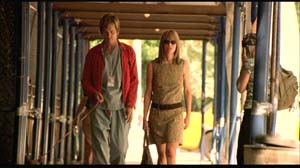
After the murder of Pauline, Malloy comes to visit Frannie, who is mourning the death of her half-sister. Malloy joins her on the bed and attempts to console her, but she starts hitting him, a physical manifestation of the ambivalence and painful uncertainty she feels toward him. He then gives her a bath, after which she dresses up and starts to play around with his hand cuffs. The hand cuffs, a signifier of violence and containment, assumes all its power because of the use she makes of them: after hand cuffing him to a pipe, she sits on him, starts to make love to him, but ordering him not to touch her, which leads him to say that he likes to watch ‘in the cut’.
The final example for our schematic contrast is the lighthouse scene, during which Rodriguez, now revealed as the killer, continually mixes violence and sex (or romantic behavior), for example, asking her to marry him, with the engagement ring dangling from the knife’s point. After the bloody finale in which she manages to shoot Rodriguez, Frannie, covered in blood, makes her way back to Malloy, still hand cuffed to the pipe and lying on the floor of her apartment, and quietly lies in his embrace.
It seems to me that in the course of the film Frannie battles with her Thanatos instinct, while being drawn to it, to her “dark side”. The force of Eros is what ‘saves’ her, but it is interesting to note that it is this very force of Eros that has led her into the dark side, for her Eros is represented by Malloy, whom she will later suspect of being the killer. This clever “battle” between Eros and Thanatos helps blur the line that separates the contrast between sex and violence: Where does sex start and where does it end? Where does violence start and where does it end? The sexual aspect of Frannie’s life is awakened by Malloy, but also by what he represents: a connection to a darker –criminal– world. “The ‘sexual’ model foregrounds the personal, more hidden aspects of past women’s lives –their dormant passions, sexual frustrations and the process of denial which governed their relationships with men.” [3]
??In the Cut??’s relation to the world of literature and words is important in the context of the themes and of the narrative. As Frannie tries to explain the concept of slang to Pauline, she is left to generalize it, concluding that slang is either sexual or violent. To better support her claim, as Pauline asks her what ‘virginia’ means, she answers that it signifies ‘vagina’ as in “He penetrated her virginia with a hammer.”
The film makes use of many double-entendres that lead to doubt and uncertainty. For example, as Rodriguez, Malloy and Frannie are riding in the car, Malloy, with a receipt in his hand, turns to Frannie and asks her if “this looks familiar?” While he bears the receipt, the tattoo on his wrist is also visible to us, and Frannie, hence the viewer is left to wonder if what he actually means by ‘this’ is the receipt, or the tattoo. We have here but one example of the possibilities of duality, which sometimes present themselves with graphic, visual examples but more often verbally, through Frannie’s interactions with the other protagonists. For example, when Rodriguez tells Frannie, on the way to the lighthouse, “I go fishing there,” “fishing” takes on a double meaning: the literal one and a symbolic one, “hunting” for women.
The title of the film (and of the book) is in itself quite meaningful in relation to the contrast I am trying to elaborate here. The word ‘in’ could be considered as the male noun, representing the violence side of the contrast because of its intrusive character: the action of entering in is violent if we compare it to receiving. As opposed to ‘in’, the word ‘cut’ is the female noun, representing sexuality because of its suggestive character: ‘cut’ as a slang word for the vagina. However, on another level of thought, the ‘cut’ could signify something violent, because of its very meaning: ‘to cut’, as does Rodriguez with the women he kills.
The relation of In the Cut to slang also exists through the character of Cornelius, Frannie’s student, who seems to try to lure her into his game of seduction by the use of words, just as he uses them to dominate her psychologically:
When he approaches Frannie with the money he owes her from the bar tab and queries her as to her long delayed return from the bathroom, she replies, “I got lost. I couldn’t find the bathroom.” His response of “Is that all?” evokes anxiety on Frannie’s part, as she imagines that Cornelius may have observed her watching the stranger receiving fellatio. In a moment marked by thrilling tension, Frannie replies, “What do you mean, is that all?” to which Cornelius says, “Is that all I owe you?” Clearly, the language operates on several levels, reflecting misunderstanding, sexual innuendo, and an unspecified range of emotion and discomfort. [4]
Furthermore, while Frannie rides the subway, excerpts of poetry and literature appear frequently on a ‘poetry-in-transit’ advertising board, quotes that seem to refer to either her actions or her state of mind:
Now
Thinking back
On the course of my passion
I was like one blind
Unafraid of the dark
This anonymous quote refers directly to what Frannie is experiencing at that moment in her life; aroused by a rising passion, even though she suspects her lover of something horrible (something dark), she can’t help but delve further into the adventure, and subconsciously she closes her eyes to her doubts and tries to ignore her fears.
As a Jane Campion film, In the Cut ‘met en scène’ the feminine dilemma: the need for an individual expressivity to confront amorous temptations. For In the Cut is, before all else, a tale of female desire, in which the mental process of a woman is given a persistent, almost clinical study. Campion succeeds at integrating elements of her directorial universe, mostly by letting a woman go further into her needs and desires, as in The Piano, or The Portrait of a Lady, two major Campion films, only this time delving deeper into the dark side of her characters than in the previous films.
“In the Cut is also about the ways in which some women may quite deliberately enter into situations fraught with danger. Like Isabel in The Portrait of a Lady or Ruth in Holy Smoke, Frannie flirts with the very forces that might do her the most harm. There is a frequent mingling in Campion films of erotic empowerement and willed masochism.” [5]
Aesthetic Concerns: Sense of Threat
The emblematic color of Eros is red, the color of passion, of love, but also of hell, of violence and murder (the blood, the flesh, the wounds). The omnipresence of red in the film might be a signifier for passion, or for what we could call the “blood” motif: red as passion or murder, love or flesh, or, in other words, as love or hate and everything in between. This “blood” motif hovers over the film, constantly bringing us back to either sex or violence. The color red appears in nearly every shot in the film, sometimes flagrantly. It appears on clothes, props and within the décor; and many key elements in the narrative are red: the lighthouse that rises beneath the bridge is flamboyant in its redness, just as the one Frannie has drawn on her classroom black board, and the one that stands on Rodriguez’s desk, and the dress she wears in the final sequences, etc. This omnipresence of red instills a sense of imminent danger, while (possibly) intensifying our emotions.
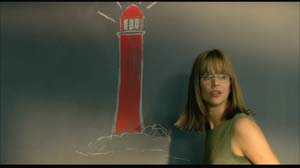
The aesthetics of the film play an integrating part in the narrative, as if they were a way to translate Frannie’s emotions to the surface of the screen. Indeed, when Frannie becomes uncertain of something, the image gets blurry and we begin to have doubts, as a viewer, as to whether what is happening on the screen is safe (will something bad happen?) or real (is Frannie drunk? Dreaming? Fantasyzing?). The sequences after Malloy gives Frannie a bath contain the most out-of-focus shots of the whole film, as if they were to signify the whole ‘danger’ character of the film. On the contrary, during moments that represent an important moment for Frannie, the aesthetics are very sharp, as if at that moment she were very conscious, very alive, very ‘present’. To continue this ‘contrast’ theory, one could say that the aesthetics of the film are either ‘violent’ or ‘soft’. The violent aesthetics being characterized by low key lighting, out-of-focus shots in darkness, hand-held camera, omnipresence of red and black, movements in the shadows or objects blocking the view of the camera, expressionist angles, and ‘odd’ close-ups (mostly when the camera is looking at Frannie from an unknown point-of-view, as if someone were watching her); the soft aesthetics being characterized by blurring in the frame, out-of-focus shots in the sunlight or daylight, the petal storm, and every trick that Campion and cinematographer Dion Beebe use to make the image look ‘feminine’, such as strange light sources, edges of the frame being blurred, deep, rich colors such as gold and crimson, and objects in the foreground delicately moving (Frannie’s hanging trinkets). This breakdown demonstrates that there is a contrast between the cold and warm aesthetics of the film, the first sinister ones relating more to a ‘violent’ state (we feel a discomfort watching them), the second ones relating rather to what is feminine, sexy, erotic, giving us an impression of dampness (the scene that could best describe this is the one in Pauline’s apartment, where Frannie reads Cornelius’ paper, and they talk about their parents and dance).

The acknowledged dream-state of the film could be interpreted at a more primal level. There are many points in the film where we could wonder if what is happening is real or only just a phantasm. The sometimes blurry image, the ever-present golden light (during day time), the sleep-walking state of Frannie, and the surrealistic petal storm at the beginning of the film are just a few elements that cast a doubt as to the ontological nature of what is happening on screen.
Is it just a coincidence that during the scene where she witnesses the fellatio, as Frannie is about to tumble into her adventure, the door mysteriously closes behind her as she descents into the basement, as if entrapping her into her own phantasm? The scene also reminds the viewer of a “descent into hell,” a metaphor underlined by Dante’s “The Inferno” quote. Then after the ‘solving’ of the case, the final turning point where Frannie understands she can finally trust the man she loves, she re-enters her apartment to go lie with him on the floor, relieved, trusting, confident. And then the door mysteriously closes on its own, which can be seen as a reaffirmation of the fairy tale feel: the cover of a book being closed after the story has ended. The story line of In the Cut in itself recalls the famous children’s fable The Little Red Riding Hood, in which a little girl, because of her curiosity, ‘strays’ off the path and comes very close to danger.
After reading the novel, literary critics were mainly disturbed by the suggestion that the heroine is seeking her own death.6 Why is it that Frannie courts danger so much? Is it because of her true inner instincts and desires, or is it because of the constraints of the genre? As a genre film, In the Cut is a key work in the corpus of films assembled under the banner of neo-noir thrillers, films in which sex and violence form a whole whose components interact in an ambiguous but inseparable way. As an erotic thriller, In the Cut stands along such films as Basic Instinct (Paul Verhoeven, 1992), Jade (William Friedkin, 1995), The Last Seduction (John Dahl, 1994) or Body of Evidence (Uli Edel, 1992).7 However, In the Cut rises above these titles, due to the intensive focus on female desire and subjectivity and its “art film” aesthetics, setting it apart from other American erotic thrillers. The strong sexual desire of the protagonists, as well as their desire for what is considered the “dark side,” the shadow, is a strong component of erotic thrillers, but In the Cut goes further than most in challenging the taboo of exploring female sexual desire. This entry in the world of the erotic thriller genre shows us that Campion is a versatile director, or maybe that she can be whatever we want her to be.
Endnotes
1 See films such as Pyscho (Alfred Hitchcock, 1960), Peeping Tom (Michal Powell, 1959), several Brian de Palma’s films, etc.
2 During the scene by the lake, Malloy, trying to share a nice romantic moment with Frannie, breaks the mood with the following conversation:
Malloy: “ Shit, I can’t get that sick fuck outta my head.”
Frannie: “While we were kissing?”
Malloy: “All the fucking time.”
Also, when they first meet at Frannie’s apartment, he tells her that a similar murder occurred about a year ago, and that he thinks they are both related, which proves that he has dedicated much of his time to the case.
3 Bruzzi, Stella. “Bodyscape.” Sight and Sound. Vol. 3 n. 10, October 1993, p. 6.
4 Park, Douglas. “Reviews: In the Cut.” Film Quarterly vol. 58 issue 4, pp. 44-45.
5 Polan, Dana. Jane Campion. United Kingdom: BFI World Directors, 2001, p. 159.
6 The endings of the book and of the film differ.
7 These titles are only a sample of what we could enumerate here.


